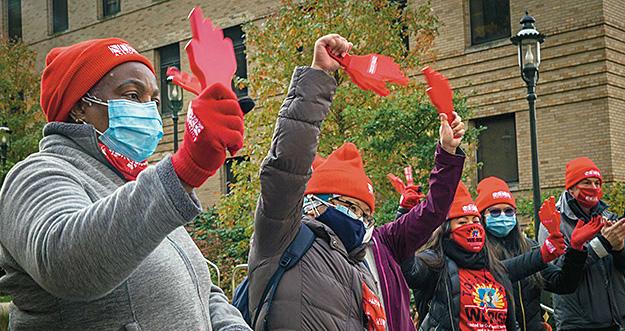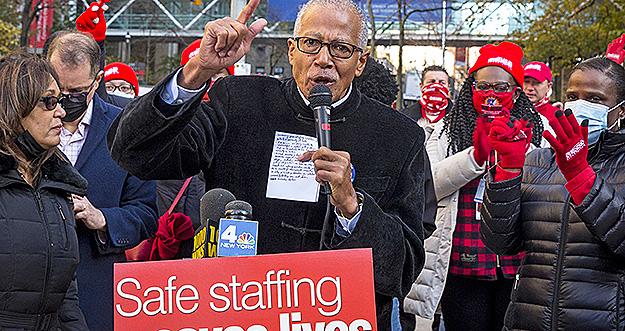Health Systems Must Do Their Fair Share

In September 2021, Gov. Kathy Hochul declared a statewide disaster emergency due to healthcare staffing shortages. Even before her declaration, many in the media drummed up a false narrative that the shortage was due to nurses who were fired or resigned in protest over the vaccine mandate. NYSNA believes every New Yorker should be vaccinated. However, mandatory vaccination programs have resulted in very few dismissals of RNs within NYSNA. More importantly, this narrative allowed health systems to evade accountability.
The truth is that the people most responsible for understaffing are the people charged with running healthcare facilities - hospital and health systems administrators. “For instance, last year many hospitals implemented a hiring freeze, which left RNs out of work and forced to seek employment elsewhere,” said NYSNA President Pat Kane. “Without detailing a clear plan, many nurses had little information on when they would return or if they could return to work. This caused some to leave the healthcare industry altogether.”
Baby Boomers Are Aging
What’s more, for years administrators have known that the aging of Baby Boomers would impose unique challenges on the healthcare system. They did little to stave off what most knew was coming.
At this point, if we do not hold health systems accountable, patients and caregivers will perish. I spoke with several RNs who detailed why.
“Understaffing of RNs is felt in many units in the facilities, including ERs, Labor & Delivery and ICUs,” said Nancy Hagans, RN, and President of NYSNA. “This is true for both private and public hospitals in NYC where NYSNA nurses work.”
We know that nurses across the state, and country for that matter, are struggling to navigate chronic understaffing. But hearing directly from so many impacted people is sobering. Dawn Cardello, RN and Co-President of the LBU at Staten Island University Hospital, said “SIUH nurses cannot continue to work in these horrendous conditions caring for 7-10 patients. Although they do their best, nurses cannot provide safe quality care when spread so thin. I have never seen it so bad in my 34-year career here.”
Other healthcare professionals with NYSNA underscore that chronic understaffing impacts public health and deserves collective attention. “Inadequate staffing is a public health concern for NYC residents,” said Board Member Benny Mathew, RN and Emergency Department nurse at Montefiore Moses Hospital. “Overcrowding and nurses are assigned to higher number of patients is recipe for disastrous outcomes which occurs on daily basis. The community and the nurses are the victims because the hospitals fail to recruit and retain nurses.”
At Capacity
According to an analysis, one in six ICUs have at least 95% capacity, yet there are not enough nurses to handle the crushing surge of patients nor is there enough staff to cover the hemorrhage of nurses leaving the profession in record numbers. With understaffing reaching a tipping point, patients and healthcare workers are at risk.
It is important to note, that staffing shortages will not go away without intentional effort. There are reportedly 4 million nurses in the U.S., and most of them work in hospitals. Given the earlier point about Baby Boomers, we know there will be a greater need for nurses in the coming years. The question becomes what are health systems doing now to plan for the future?
This Catastrophe Has Consequences
In a pre-COVID 2020 study carried out by Linda Aiken, Founding Director of the Center for Health Outcomes and Policy Research, University of Pennsylvania School of Nursing, there is evidence a much lower ratio of nurse-to-patient quota is imperative to quality patient care and saving lives:
The Safe Staffing for Quality Care Act (S.1032/A.2954) calls for nurses to care for no more than 4 patients each on adult medical and surgical units. Our findings show that on average, hospital nurse staffing is significantly worse than the proposed standard. Across all hospitals in the state, nurses care for on average 6.3 patients each. Nurse staffing was worst in New York City where nurses cared for an average of 6.9 patients each.
A hospital isn’t a McDonalds. The consequences of understaffing are more severe than a meal being delayed. When low staffing impacts quality care, lives are impacted - both the patients and the nurses providing care. Understaffing is a catastrophe that has consequences.
Aretha Morgan, RN, who has worked in the Pediatric Emergency Department for 11 years, lamented “I have never seen staffing like. It is devastating. Patients are suffering. Instead of hiring, management froze positions. How is that safe?”
Echoing that point, Noemia Dejesus-Aponte, RN at New York Presbyterian said, “In the ER, patients can be ignored for hours and hours. It is a shame!” Dejesus-Aponte continued, “The Obstetrics unit needs nurses. We cannot safely care for newborns, high risk babies with this staffing. Newborn hospitalizations are 1-2 days when it should be a week. Understaffing compromises patient safety.”
At Maimonides Medical Center in Brooklyn, where Hagans has worked for 31 years, management allegedly froze positions all over the state. “It’s time to hire nurses,” Hagans said. “Once they hired, management must work on retention. One thing that is clear is that relying on travel nurses is an unsustainable band-aid.”
Declaring the Emergency
This is not care; this is not what many nurses signed up for when they entered the profession. Hospital administrators and health system leaders must do their fair share. It is wholly inappropriate to leave the entire burden of caring for those who are ill to nurses.
Faced with physical, emotional, and ethical challenges, nurses are ringing the alarm. Many kicked off a series of rolling actions to detail dangerous understaffing at some of the state’s most prominent care facilities. The NewYork-Presbyterian Columbia Hospital November 17th Day of Action and Speak Out was the first. Another occurred on November 23rd, with more to follow. Nurses and other healthcare workers appreciate that the best way to push back is to unite together and demand change. They understand that understaffing is not isolated to one facility, but rather a systemwide challenge.
Perceptions Must Shift
New York State Senator Robert Jackson attended the Nov. 17 NewYork-Presbyterian Columbia Hospital Speak Out and proclaimed, “Thirty-to-one is absolutely crazy!” Anthony Feliciano, Director of the Commission on the Public’s Health System added, “Safe staffing saves lives, is the reality.”
Across the country, and certainly in New York, more and more nurses are noting that the public must shift how we think about caregiving. It is not just the responsibility of nurses and other healthcare workers to support those who are sick. Hospital systems too have a responsibility and must be held accountable for staffing shortages and other workplace challenges.
Links
[caption caption="New York State Senator Robert Jackson attended the November 17 NewYork-Presbyterian Columbia Hospital Speak Out." align="center"]